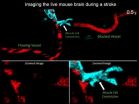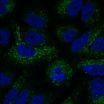Solving the next step in the mystery of prions
UAlberta scientists aim to understand how proteins convert from a normal structure to a diseased state
2015-06-25
(Press-News.org) EDMONTON, Alberta, June 25 -- Working towards the ultimate goal to develop therapeutics to treat diseases such as Alzheimer's, Parkinson's, ALS, and BSE (Mad Cow Disease), University of Alberta scientists Michael Woodside, Hao Yu, and Derek Dee are investigating the physical principles underlying the formation of misfolded protein aggregates. The aggregates of misfolded proteins -- proteins that clump together in the "wrong" structure -- feature prominently in these fatal degenerative diseases.
"This is the big mystery we're trying to solve," says Woodside, a professor of physics. "We want to understand the physics of the conversion from 'good' proteins to 'bad.'" Understanding the conversion process should lead to finding new targets for drug development. Woodside's research group is one of the world leaders in the area of single-molecule studies of protein misfolding.
A couple of years ago, the UAlberta researchers examined a single prion protein molecule to study how it behaves in isolation. However, it is in the interaction between molecules which is important in disease. To further the journey along the road to the eventual development of possible treatments, Woodside and his colleagues have now studied the interaction of two molecules. In contrast to single isolated molecules, in which incorrect structures did not last very long, two molecules interacting together could form an incorrect structure that was more stable than the correct one. The group used sensitive laser tweezers to manipulate the proteins and observe the microscopic motions of the molecules as they changed shape.
Their most recent discovery opens a new window onto the microscopic mechanisms governing protein misfolding. Says Woodside, "Our work is best viewed as just one step in solving a big mystery that still endures almost 20 years after the Nobel Prize was awarded for the prion hypothesis."
INFORMATION:
"Protein misfolding occurs by slow diffusion across multiple barriers in a rough energy landscape" was published in the scientific journal, Proceedings of the National Academy of Sciences of the United States of America. The research was conducted at the National Institute for Nanotechnology at the University of Alberta, supported by the Alberta Prion Research Institute, PrioNet Canada, AITF, AIHS, NSERC, and NINT.
Home to more than 6500 undergraduate, 1300 graduate students, and more than 300 faculty,
the University of Alberta Faculty of Science is committed to excellence in research and teaching.
Contact:
Jennifer Pascoe
jennifer.pascoe@ualberta.ca
780-492-8813
http://www.science.ualberta.ca
ELSE PRESS RELEASES FROM THIS DATE:
2015-06-25
INDIANAPOLIS -- Indiana University cancer researchers found that a particular microRNA may be a potent therapeutic agent against pancreatic cancer. The research was published June 22 in the journal Scientific Reports.
Led by Janaiah Kota, Ph.D., assistant professor of medical and molecular genetics at the IU School of Medicine and a researcher at the Indiana University Melvin and Bren Simon Cancer Center, the researchers found that restoring missing microRNA-29 (miR-29) in pancreatic cancer stromal cells reduced the viability and growth of the cancerous cells.
A thick ...
2015-06-25
A new study published in the Articles in Advance section of Transportation Science, a journal of the Institute for Operations Research and the Management Sciences (INFORMS), improves how air traffic managers cope with unexpected delays and provides them with more predictable ways to manage arrival traffic at airports with adverse weather.
The study, Incorporating Predictability into Cost Optimization for Ground Delay Programs, is by Yi Liu and Mark Hansen of the University of California, Berkeley. Ms. Liu received honorable mention for her research in the 2013 INFORMS ...
2015-06-25
Scientists from Ludwig-Maximilians-Universitaet (LMU) in Munich and the Max Planck Institute for Quantum Optics can image the optical properties of individual nanoparticles with a novel microscope.
Nanomaterials play an essential role in many areas of daily life. There is thus a large interest to gain detailed knowledge about their optical and electronic properties. Conventional microscopes get beyond their limits when particle size falls to the range of a few 10 nanometers where a single particle provides only a vanishingly small signal. As a consequence, many investigations ...
2015-06-25
The American Association for the Study of Liver Diseases (AASLD), in partnership with the Infectious Diseases Society of America (IDSA) and in collaboration with the International Antiviral Society-USA (IAS-USA), created online Recommendations for Testing, Managing, and Treating Hepatitis C in 2014 to aid practitioners treating patients infected with hepatitis C virus (HCV). Now an update to the Guidance, with a summary of recommendations regarding treatment with direct-acting antiviral drugs, is published in the AASLD journal, Hepatology.
HCV is a blood-borne virus ...
2015-06-25
(Philadelphia, PA) - In a life-threatening situation, the heart beats faster and harder, invigorated by the fight-or-flight response, which instantaneously prepares a person to react or run. Now, a new study by researchers at Temple University School of Medicine (TUSM) shows that the uptick in heart muscle contractility that occurs under acute stress is driven by a flood of calcium into mitochondria--the cells' energy-producing powerhouses.
Researchers have long known that calcium enters mitochondria in heart muscle cells, but the physiological role of that process was ...
2015-06-25
When neurons become active, they call for an extra boost of oxygenated blood -- this change in the presence of blood in different regions of the brain is the basis for functional brain scans. However, what controls this increase or decrease in blood supply has been a long-standing debate.
In a paper published on June 25 in Neuron, Yale University scientists present the strongest evidence yet that smooth muscle cells surrounding blood vessels in the brain are the only cells capable of contracting to control blood vessel diameter and thus regulate blood flow. This basic ...
2015-06-25
Think the nest of cables under your desk is bad? Try keeping the trillions of connections crisscrossing your brain organized and free of tangles. A new study coauthored by researchers at UC San Francisco and the Freie Universität Berlin reveals this seemingly intractable job may be simpler than it appears.
The researchers used high-resolution time-lapse imaging of the developing brains of pupal fruit flies (Drosophila melanogaster) paired with mathematical simulations to unravel a trick of neural wiring that had stumped neuroscientists for decades. They discovered ...
2015-06-25
Adult fruit flies given a cancer drug live 12% longer than average, according to a UCL-led study researching healthy ageing. The drug targets a specific cellular process that occurs in animals, including humans, delaying the onset of age-related deaths by slowing the ageing process.
The study published today in Cell and funded by the Max Planck Society and Wellcome Trust shows for the first time that a small molecule drug, which limits the effects of a protein called Ras, can delay the ageing process in animals. The treated fruit flies outlived the control group by staying ...
2015-06-25
Boston, MA -- A new study led by researchers at Harvard T.H. Chan School of Public Health finds that a malaria parasite protein called calcineurin is essential for parasite invasion into red blood cells. Human calcineurin is already a proven target for drugs treating other illnesses including adult rheumatoid arthritis and lupus, and the new findings suggest that parasite calcineurin should be a focus for the development of new antimalarial drugs.
"Our study has great biological and medical significance, particularly in light of the huge disease burden of malaria," said ...
2015-06-25
LA JOLLA--As a tumor grows, its cancerous cells ramp up an energy-harvesting process to support its hasty development. This process, called autophagy, is normally used by a cell to recycle damaged organelles and proteins, but is also co-opted by cancer cells to meet their increased energy and metabolic demands.
Salk Institute and Sanford Burnham Prebys Medical Discovery Institute (SBP) scientists have developed a drug that prevents this process from starting in cancer cells. Published June 25, 2015 in Molecular Cell, the new study identifies a small molecule drug that ...
LAST 30 PRESS RELEASES:
[Press-News.org] Solving the next step in the mystery of prions
UAlberta scientists aim to understand how proteins convert from a normal structure to a diseased state

